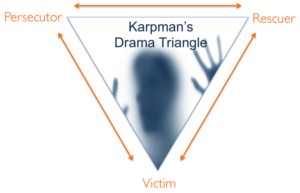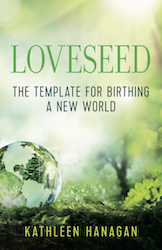“Most of the successful people I’ve known are the ones who do more listening than talking.”
Bernard M. Baruch

Listen to the blog post here:
In this time of gender turmoil and waves of chaos influencing all relationships, it takes a stronger vow and more devotion to co-create a conscious relationship. The rules are changing so quickly and are contextual, but there are some guidelines that remain, like kindness and truth, and staying out of emotional triangles. Stephen Karpman, M.D., who was a student studying under Eric Berne, the father of transactional analysis, conceived of a model, now called the Karpman drama triangle, in which the triangle maps a type of destructive interaction that can occur between people in conflict.
Karpman used triangles to map conflicted or drama-intense relationship transactions. He defined three roles in the conflict: Persecutor, Rescuer (the one-up position), and Victim (one-down position) and placed these three roles on an inverted triangle and referred to them as being the three aspects or faces of drama. The names of the roles stand for themselves, and indeed, such a triangle can trigger reactions of epic proportions.
A drama triangle can arise when someone takes on the role of victim or perpetrator, and where there is a victim, there’s always a perpetrator. Victims tend to blame external persons, places, and things as the cause of their misery. This one-down person then feels the need to enlist other support and triangulates by bringing another person, or people, into the conflict. These enlisted players then take on roles of their own that have their own dynamic quality, and all kinds of twists and turns can occur.
Often the victim might turn on the rescuer, the rescuer then switches to persecuting—or as often happens, becomes a victim. In some cases, the relationship between the victim and the rescuer can be totally symbiotic, and enmeshed, where the rescuer keeps the victim dependent on them by encouraging their victimhood.
My client Chuck was beside himself because his mother would not speak to his wife, Marie, and would not tell Marie why. His mother came to Chuck, expecting him to be the great peacekeeper that he had always been in their chaotic family. Chuck dutifully communicated with Marie, trying to influence his wife to apologize to his mother for something that was between them, which felt like betrayal to Marie. This was creating a huge wedge between Chuck and Marie, as the ongoing drama where his mother funneled anger through Chuck was eroding trust in their marriage. Chuck felt alternatingly helpless, angry at his mother, and angry at Marie for not being willing to appease his mother.
If someone enlists you to be the rescuer in a situation where their issue is with another person, it is so important that you encourage them to return to the other person if possible. Never be the go-between, no matter how great your need to be heroic. ![]()
Chuck finally did let his mother know that he had learned about triangles and that from now on he would stop his mother from telling him what she needed to say to Marie. This was setting a boundary, which his mother felt at first victimized by (notice the pattern), but which she eventually came to honor after attempting to get Chuck to slide back into his old rescuing behavior several times. Chuck spoke with his wife and apologized, having put himself in his wife’s place and having realized how hurt Marie had been. It often takes some heavy-duty cleaning up after you’ve been stuck in an emotional triangle.
The triangle is the most stable of all geometric forms, and the drama triangle stops the flow of emotions between the two people in conflict. If you remember that conflict is connection trying to happen, then there is no real connection because it is interrupted by the rescuer. Each participant in the triangle is getting their unspoken and frequently unconscious psychological wishes/needs met in a way that gives them some meaning, but is not above board, and far from conscious. The rescuer may need to feel heroic, the victim cared for, the perpetrator justified in feeling as if no one gets them—like a victim.
In truth, there is no “winning” with a triangle, and only a senseless series of misperceptions and projections. No one is acknowledging the real issue, as the heat gets turned up between the players and feelings get hurt. No one is nourished, the dynamic is toxic, and everyone loses energy in some way.
Dyads are dynamic, and just keeping it between you and another person puts you at risk of not getting your needs met, so it takes more courage. When you let another person know how you feel toward them, you are in a very deep level of intimacy, and often people just don’t have the skill to navigate those waters masterfully.
The best thing you can possibly do to improve your ability to have positive intimate encounters is to become a really skillful listener, and to deal with conflict directly, with the person you have it with. Instead of taking things personally, be curious about the other person’s view. Taking the other person in is an act of love and generosity, whereas taking them on is an act of mistrust. ![]() The teacher Abraham says, “You don’t have to worry about what their vibration is, because if your vibration is one of connection, you’re going to dominate the vibration.” When you listen deeply and seek to know the other person’s side, you will know the best way to respond. Sometimes, it just needs to be “that is not my business. I prefer not to talk about my friend’s dealings with you,” setting a boundary, because you want to protect your relationship and your own energy as well. It takes courage, and signals to others that you are a trustworthy person who respects yourself and others, and sets the tone for the kind of relationships you want in your life.
The teacher Abraham says, “You don’t have to worry about what their vibration is, because if your vibration is one of connection, you’re going to dominate the vibration.” When you listen deeply and seek to know the other person’s side, you will know the best way to respond. Sometimes, it just needs to be “that is not my business. I prefer not to talk about my friend’s dealings with you,” setting a boundary, because you want to protect your relationship and your own energy as well. It takes courage, and signals to others that you are a trustworthy person who respects yourself and others, and sets the tone for the kind of relationships you want in your life.



I really love this post. It explains the dysfunction of the drama triangle beautifully.